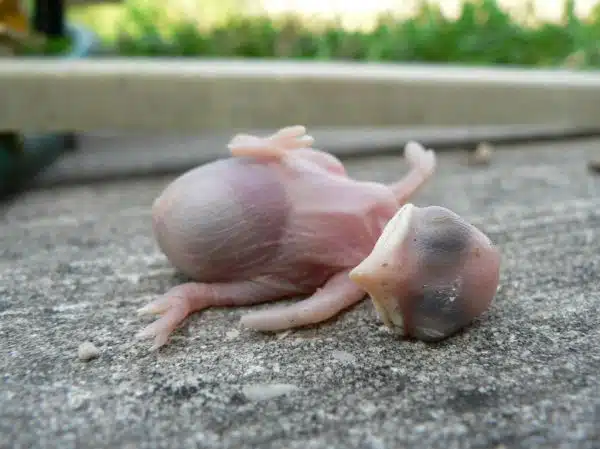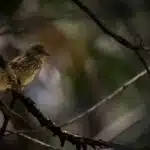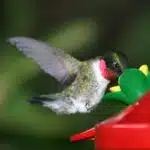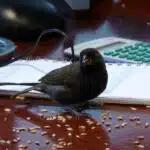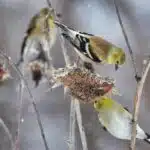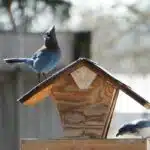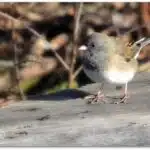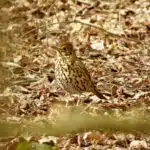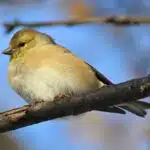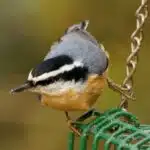As an avian veterinarian, it is essential to recognize the signs of a sick or dying bird. Birds are unique creatures with intricate systems that may not always display obvious symptoms of distress. Therefore, observing and understanding their behavior can provide valuable insight into their health status.
The importance of recognizing a sick or dying bird cannot be overstated as early detection can mean the difference between life and death. In this article, we will discuss some common indicators to help you identify when your bird is unwell. By learning how to recognize these signs, you can take prompt action to seek medical attention for your feathered friend and ensure they receive the care they need in a timely manner.
Importance Of Monitoring Bird Health
Monitoring the health of a bird is crucial for its well-being and longevity. It is essential to recognize the signs of illness or injury in birds and seek medical care promptly. As an avian veterinarian, I have seen several cases where owners failed to notice symptoms until it was too late, resulting in irreversible damage or death.
Preventative measures such as regular check-ups, vaccinations, and maintaining a clean environment can significantly reduce the risk of common illnesses in birds. These measures are particularly important if you have multiple birds living together as they are more susceptible to contagious diseases. It is vital to keep an eye out for any changes in behavior or appearance, such as lethargy, loss of appetite, discharge from eyes or nostrils, or behavioral changes.
Understanding normal bird behavior can help you identify when your bird is not feeling well. Birds are masters at hiding their illness because showing weakness can make them vulnerable to predators in the wild. However, some subtle changes in behavior can indicate that something is wrong. Familiarizing yourself with your bird’s habits and routines will help you recognize these changes quickly and take appropriate action. In the following section, we will discuss how to understand normal bird behavior and spot potential red flags that indicate sickness or injury.
Understanding Normal Bird Behavior
As an avian veterinarian, it is important to understand normal bird behavior before recognizing signs of illness. Understanding bird body language is a crucial aspect of this. Birds communicate with their bodies, and their movements can tell us a lot about how they are feeling. For example, a bird that is fluffed up and sitting on the bottom of its cage may be sick or stressed, while a bird that is perched upright with feathers smooth and eyes bright is likely healthy.
Another important aspect of understanding normal bird behavior is reading bird facial expressions. Like humans, birds use facial expressions to communicate how they are feeling. A relaxed beak and bright eyes indicate a happy and contented bird, while a closed or partially open beak and squinted eyes may indicate stress or discomfort. It’s also important to pay attention to the position of the head – a head held high with feathers fluffed can indicate aggression or fear.
By understanding normal bird behavior, you will be better equipped to recognize when something isn’t right with your feathered friend. However, it’s important to remember that every bird is unique in its behavior and personality. Regularly observing your bird’s body language and facial expressions will help you establish what is normal for them so you can quickly recognize any changes that could signal illness or distress.
Transition: While it’s essential to understand normal bird behavior when recognizing signs of illness, there are physical signs that should also be considered when monitoring your pet’s health.
Physical Signs Of Illness
Identifying symptoms of illness in birds can be challenging since they are masters of hiding their weakness. However, it is essential to keep an eye on any subtle changes in their behavior or physical appearance that may indicate a problem. One of the most common symptoms is lethargy, where the bird appears to be weak and lacks energy. Birds that are usually active but become suddenly inactive or less responsive may also be experiencing health issues.
Another sign to look for is abnormal breathing patterns. Birds with respiratory problems may exhibit open-mouthed breathing, wheezing, coughing, or sneezing. If you notice your bird struggling to breathe or showing other signs of respiratory distress, seek treatment from an experienced avian veterinarian immediately.
Lastly, observe your bird’s feathers and skin regularly for any abnormalities such as bald patches, sores, lumps, or discoloration. These could indicate skin infections or mites. In addition to these symptoms mentioned above, there might be many other indicators of sickness that vary depending on the species and breed of your feathered friend.
- Lethargy
- Abnormal breathing patterns
- Feather and Skin abnormalities
It is vital to note that seeking treatment as soon as you suspect your bird is unwell can significantly increase the chances of a successful recovery. Avian veterinarians have specialized training in diagnosing and treating avian illnesses and can guide you on how best to care for your sick bird at home while ensuring its comfort and well-being. Remember always; early intervention is crucial when dealing with sick birds.
As we move onto the subsequent section about changes in eating habits, keep in mind that changes in feeding patterns are often one of the first signs that something may be amiss with our feathered friends’ health.
Changes In Eating Habits
Physical signs of illness can be easily observed in birds. These signs include changes in posture, feather quality, and breathing patterns. Sick birds may also exhibit a lack of energy and decreased activity levels. Observing behavior is crucial in recognizing when a bird is sick or dying. Birds that exhibit unusual behaviors such as lethargy, disorientation, or unresponsiveness may be showing signs of an underlying illness.
When you suspect that your bird is sick or dying, seeking veterinary advice should be your first course of action. A qualified avian veterinarian can perform a physical examination to determine the underlying cause of the symptoms and recommend appropriate treatment options. Early detection and treatment are critical to ensuring the best possible outcome for your bird’s health.
Changes in eating habits are often one of the first signs that a bird is ill. However, changes in drinking habits can also indicate an underlying issue with their health. In the next section, we will discuss how to recognize changes in drinking habits and what they could mean for the well-being of your bird.
Changes In Drinking Habits
Birds are unable to survive without water, and it is essential for their overall health. Changes in drinking habits can be an indication of sickness or dehydration. Monitoring the water consumption of your bird is crucial in preventing dehydration and identifying any potential issues.
Dehydration prevention should be your priority as a bird owner. It is necessary to ensure that clean water is always available to your bird. Dirty water can cause infections and discourage birds from drinking. You must also change the water frequently, especially during hot weather or if your bird has diarrhea, as this can lead to dehydration.
Monitoring the amount of water consumed by your bird will help you identify any unusual behavior. A decrease in water consumption may indicate an underlying health issue, while increased consumption may indicate an increase in physical activity or hot weather conditions. Keeping track of these changes will allow you to take prompt action if necessary and prevent further complications.
- Ways to monitor your bird’s drinking habits:
- Use a clear water bottle that allows you to see how much water has been consumed.
- Keep a logbook of how much water is consumed daily.
- Add some fruits or vegetables with high-water content to their diet.
Incorporating these methods into your routine will help you recognize changes in drinking behavior promptly, enabling you to take action before it becomes problematic. The next section will discuss changes in vocalizations that could indicate sickness or discomfort in birds.
Changes In Vocalizations
Recognizing vocalizations is an essential step in identifying a sick or dying bird. Birds have a unique way of communicating with each other, and their vocalizations can indicate the state of their health. As an avian veterinarian, it is crucial to understand and interpret bird sounds to identify any abnormalities.
Healthy birds produce clear and consistent calls that indicate their well-being. However, sick or dying birds may produce weak, raspy, or inconsistent sounds. Some birds may become completely silent, indicating severe illness or discomfort. Therefore, it is essential to observe changes in the bird’s vocalizations over time and compare them with their typical sounds.
Interpreting bird sounds requires experience and knowledge of avian behavior. It is recommended to record the bird’s vocalizations for later analysis if you suspect that it is sick or dying. This will provide valuable information for diagnosis by your veterinarian. Always remember to approach a sick or dying bird with caution as they may be aggressive towards humans due to fear or discomfort.
Recognizing changes in a bird’s vocalizations can be challenging but crucial for early detection of illness. In the next section, we will discuss another vital sign that can indicate a sick or dying bird – changes in droppings. By combining observations of vocalizations and droppings with other signs such as appetite loss and lethargy, you can create a comprehensive picture of your bird’s overall health status.
Changes In Droppings
Avian droppings are an important indicator of the bird’s health status, so any changes should be noted. Changes in color, volume, and consistency of droppings might be indicative of a disease or health issue. Variations in the color of droppings can range from green to yellow and brown and could be a sign of a dietary issue or illness. Abnormal increases or decreases in the volume and consistency of droppings could also be an indication of a health issue.
Change In Color
Color changes in birds can be an indication of an underlying health issue. As an avian veterinarian, I have observed that many bird owners tend to overlook these changes as they are often subtle and can easily go unnoticed. However, it is crucial to keep a close eye on your bird’s colors as it could be a vital sign of their overall health.
One possible cause of color changes in birds may be due to liver dysfunction, which affects the production of pigments responsible for feather coloration. In such cases, the feathers may appear dull or discolored. Other possible causes include infections or dietary deficiencies. Treating this issue will depend on the underlying cause; hence, a proper diagnosis is necessary before prescribing any treatment.
Preventing color changes due to liver dysfunction or other underlying health issues involves providing a healthy diet rich in vitamins and minerals. Avoid exposing your bird to environmental toxins as they can damage the liver and other organs. Regular check-ups with your avian veterinarian are also essential in identifying any potential health problems before they become severe.
In conclusion, keeping a close eye on your bird’s colors is crucial for identifying any potential health problems early on. If you notice any changes, seek veterinary care immediately to ensure timely treatment and prevent further complications from occurring. Remember that prevention is always better than cure; therefore, providing your bird with a healthy diet and environment is key to maintaining their overall well-being.
Change In Volume
As an avian veterinarian, it is my duty to educate bird owners on the various signs and symptoms that may indicate potential health problems in their feathered friends. Changes in droppings are often one of the first things that bird owners notice when something isn’t right. One aspect of this change that may be overlooked is bird volume changes, which can provide valuable insight into a bird’s overall health.
Bird volume changes refer to any variations in the frequency or intensity of a bird’s vocalizations. Birds use vocalizations to communicate with their owners, other birds, and even predators. A happy and healthy bird will typically have consistent vocalizations that reflect its personality and behavior patterns. However, if you notice a sudden increase or decrease in your bird’s vocalizations, it may be a sign of stress or illness.
Understanding bird vocalizations can be challenging for those who are not familiar with avian communication patterns. That is why regular check-ups with your avian veterinarian are crucial to identifying any potential health problems early on and ensuring prompt treatment. Additionally, providing your bird with proper nutrition and environmental enrichment can help reduce stress and prevent illnesses from occurring in the first place. By paying attention to your bird’s volume changes and seeking veterinary care as needed, you can help ensure that your feathered friend lives a long and healthy life.
Changes In Feather Appearance
Changes in droppings can provide valuable information about a bird’s health, but it is not the only indicator. Another important factor to consider is feather appearance. Molting patterns and stress-related feather plucking can indicate illness or distress in a bird. Molting is a natural process where birds shed old feathers and grow new ones, but if this process is disrupted or delayed, it could be a sign of underlying health issues. Additionally, if a bird is constantly plucking its feathers or has bald patches on its body, it may be experiencing stress or anxiety.
Feather health is closely tied to diet and environmental factors. A poor diet lacking in essential nutrients can result in dull, frayed feathers that break easily. On the other hand, an excess of certain nutrients like vitamin A can lead to abnormal feather growth and coloring. Environmental factors like exposure to toxins or extreme temperatures can also impact feather health. For example, birds that are exposed to cigarette smoke may have discolored feathers and reduced lung function.
As an avian veterinarian, I recommend regularly monitoring your bird’s feather appearance as part of their overall health assessment. If you notice any abnormalities like molting delays or excessive feather plucking, it may be time for a check-up with your vet. Additionally, ensuring your bird has access to a balanced diet and safe environment can help promote healthy feathers and overall well-being.
Feather appearance is just one aspect of recognizing sickness or distress in birds – changes in energy level are another important sign to look out for. As birds are often highly active animals with high metabolic rates, changes in their energy levels could signify underlying issues that require attention.
Changes In Energy Level
According to recent studies, changes in energy level can be a sign of sickness or dying birds. A bird that is sick usually has a reduced activity level and may exhibit lethargy, weakness, or fatigue. The bird may also spend more time sleeping than usual. Conversely, a dying bird may become more agitated or restless as it senses the end of its life.
Behavioral changes are often one of the first indicators that something is not right with a bird’s health. If you notice any changes in your bird’s behavior, it is essential to take action quickly to ensure its well-being. Environmental factors can also play a significant role in affecting a bird’s energy level and behavior. Changes in temperature, humidity, lighting, and noise levels can all impact how active or lethargic your bird appears.
To help you better understand what behavioral and environmental changes could mean for your feathered friend’s health, refer to the table below:
| Behavioral Changes | Possible Health Issue |
|---|---|
| Reduced activity | Illness/Injury |
| Lethargy | Infection |
| Weakness/Fatigue | Nutritional Deficiency |
| Agitation/Restlessness | End-Stage Disease |
Remember that every bird is unique, and while these signs can indicate sickness or dying birds, they do not necessarily guarantee such an outcome. As an avian veterinarian, I encourage you to pay attention to any changes in your bird’s energy levels carefully. Your quick response could make all the difference in saving their life.
As we move on to the next section about respiratory distress, keep in mind how behavioral changes and environmental factors can affect your feathered friend’s health. These are all essential considerations when examining possible causes of respiratory distress in birds.
Respiratory Distress
A decline in energy level is one of the earliest signs of sickness or dying in birds. It is important to note, however, that not all birds will exhibit this symptom when they’re ill. Some may still appear energetic and alert despite being sick. That said, it is crucial to pay close attention to your bird’s behavior and energy level on a regular basis.
Prevention strategies are essential in keeping your bird healthy. A well-balanced diet, clean living conditions, and proper hygiene are necessary components of maintaining optimal health for your avian pet. Regular check-ups with an avian veterinarian can also help detect any potential health issues early on, allowing for prompt treatment.
When respiratory distress occurs alongside a decline in energy level, it could indicate a serious underlying condition. Treatment options may vary depending on the severity of the illness and its root cause. An avian veterinarian will conduct a thorough examination to determine the best course of action for your bird’s specific condition. Early detection and prompt treatment can increase the chances of recovery and improve your bird’s quality of life.
As neurological symptoms can also be indicative of a sick or dying bird, it’s important to be aware of these signs as well. These symptoms include loss of balance, tremors, seizures, and changes in behavior or personality. If you notice any neurological symptoms in your bird, seek veterinary care immediately as they could be signs of a serious condition that requires urgent treatment.
Neurological Symptoms
Neurological symptoms in birds can be difficult to identify, but they are important indicators of a sick or dying bird. One of the most common neurological symptoms is a loss of balance, which can occur for a variety of reasons. Assessing balance in a bird involves observing its ability to stand and walk normally, as well as watching for any wobbling or falling over. If a bird is unable to maintain its balance, it may have an underlying neurological issue that requires medical attention.
Another common neurological symptom is seizures. Seizures can be caused by a number of factors, including infections, head trauma, and poisoning. Identifying seizures in birds involves observing the bird’s behavior and looking for sudden movements or convulsions. It is important to note that seizures can be life-threatening and require immediate veterinary care.
In summary, assessing balance and identifying seizures are two important components of evaluating neurological symptoms in birds. These symptoms may indicate serious underlying health issues that require prompt attention from an avian veterinarian. In the following section, we will discuss eye and beak abnormalities as additional signs of illness in birds.
Eye And Beak Abnormalities
Neurological symptoms in birds can be a sign of various underlying health conditions. However, it is not the only sign to look out for when determining if a bird is sick or dying. Another important aspect to consider is eye and beak abnormalities. These are often visible signs that suggest there may be an underlying health problem.
Beak malformations can occur due to several reasons such as genetics, injury, or disease. A bird’s beak is essential for eating and grooming, so any deformity can severely affect its quality of life. Some common types of beak malformations include overgrown, crossed or misaligned beaks. These can cause difficulty in feeding, leading to weight loss and malnutrition.
Eye infections are another common problem in birds that can lead to severe complications if left untreated. Symptoms of an eye infection may include redness, discharge from the eyes, swollen eyelids or even blindness. It is crucial to identify these symptoms early on and seek veterinary care immediately to prevent further damage to the bird’s eyesight.
In summary, recognizing eye and beak abnormalities are essential in determining whether a bird is sick or dying. Beak malformations can cause difficulty with feeding and grooming while eye infections can lead to permanent damage if left untreated. Early identification of these symptoms followed by prompt veterinary care can significantly improve the chances of recovery for the bird. As we move forward into the next section about wound care, it is important to keep in mind that proper diagnosis of underlying health problems must precede wound treatment for effective healing.
Wound Care
- Assessment of any potential wounds on birds should be conducted by a qualified avian veterinarian to determine the extent of the injury and the appropriate course of treatment.
- An injured bird should be carefully examined for any visible wounds, which may include feather loss, exposed skin, or misshapen feathers.
- The treatment of wounds on birds requires the use of specialized equipment, medications, and techniques to ensure the safety and health of the bird.
- In cases of severe or life-threatening wounds, the bird may require supportive care and/or hospitalization to ensure the best possible outcome.
Assessing Wounds
When assessing wounds in birds, it is important to approach the situation calmly and carefully. Begin by gently restraining the bird and examining the wound for its severity. Determine if there are any foreign objects present and remove them carefully if possible. If the wound is bleeding, apply pressure using a clean cloth or gauze until the bleeding stops.
Once the wound has been assessed, cleaning it should be your next step. Use a mild antiseptic solution to clean the area around the wound thoroughly. Avoid getting any solution directly on the wound itself as this may cause further irritation or infection. After cleaning, apply an ointment specifically designed for avian injuries to promote healing.
Keep in mind that some wounds may be too severe for at-home treatment and require immediate veterinary attention. Attempting to treat these wounds yourself may worsen the situation and put your bird’s health at risk. Always consult with an avian veterinarian if you are unsure of how to proceed with treating a wound.
Treating Wounds
Wound care is an essential aspect of ensuring the overall health and well-being of birds. Birds are prone to various types of injuries, such as lacerations, punctures, and abrasions, which require immediate attention. As an avian veterinarian, I highly recommend that bird owners approach the situation calmly and carefully when assessing wounds in their pets.
After assessing the wound’s severity, it is crucial to clean the affected area thoroughly. Cleaning wounds involves using a mild antiseptic solution to clean the area around the wound carefully. Avoid getting any cleaning solution directly on the wound itself as this may cause further irritation or infection. After cleaning, it is essential to apply medication specifically designed for avian injuries to promote healing.
It is important to note that some wounds may be too severe for at-home treatment and require immediate veterinary attention. Attempting to treat these wounds yourself may worsen the situation and put your bird’s health at risk. As an avian vet, I advise you always consult with a professional if you are unsure of how to proceed with treating a wound. Proper wound care can make all the difference in your bird’s recovery process and overall health.
Emergency First Aid
As an avian veterinarian, I have seen many bird injuries that require emergency first aid. One of the most common injuries is a broken wing. This is often caused by flying into a window or being attacked by a predator. When faced with this kind of injury, it is important to act quickly and calmly. Using a towel or blanket, gently wrap the bird and keep it in a warm and quiet place until further care can be provided.
Another common bird injury that requires immediate attention is bleeding. Whether it’s from a cut or puncture wound, blood loss can quickly become life-threatening for birds. To stop bleeding, apply pressure to the wound with a clean cloth or gauze. If the bleeding does not stop within 10 minutes, seek professional help immediately.
In addition to these injuries, there are many other types of injuries that birds can sustain. These include broken bones, burns, and respiratory distress. Knowing how to recognize and treat these injuries can mean the difference between life and death for your feathered friend. By educating yourself on emergency first aid and having necessary supplies on hand (such as gauze, hydrogen peroxide, and tweezers), you can provide immediate care when needed. However, it is important to remember that emergency first aid is only the first step in treating injured birds – seeking professional help from an avian veterinarian should always be the next priority for their long-term health and recovery.
Seeking Professional Help
Finding a veterinarian who specializes in avian care is crucial for those with sick or dying birds. A qualified avian veterinarian will have the necessary expertise to diagnose and treat the bird’s condition. It is important to research the education and experience of potential veterinarians, as well as their availability for emergency care.
In the event of an emergency, it is important to know what emergency care options are available. Some veterinary clinics offer 24-hour emergency services, while others may refer patients to a nearby animal hospital. It is important to have a plan in place before an emergency occurs, including identifying the closest emergency care facility and keeping their contact information on hand.
When seeking professional help for a sick or dying bird, time is of the essence. Delaying treatment can lead to further complications and potentially even death. By finding a qualified avian veterinarian and knowing available emergency care options, owners can ensure that their feathered friend receives the best possible care when they need it most.
Conclusion
Monitoring the health of your bird is crucial to ensure its well-being. As an avian veterinarian, I cannot stress enough the importance of being able to recognize the signs of a sick or dying bird. Understanding normal bird behavior is essential in identifying any deviations from it.
Physical signs such as changes in eating and drinking habits, eye and beak abnormalities, and wound care are all indicators of illness. Emergency first aid measures can be taken to help alleviate symptoms, but seeking professional help should not be overlooked. It is ironic how often people wait until it’s too late to bring their birds in for medical attention.
As an avian veterinarian, I urge you to take a proactive approach in monitoring your bird’s health. Regular check-ups and a keen eye for any abnormalities can make all the difference in catching illnesses early on. The well-being of your feathered friends should never be taken for granted, so don’t hesitate to seek professional help if needed. Remember, prevention is key – don’t wait until it’s too late!
Image Credits
- “dying baby bird” by rkimpeljr (featured)

